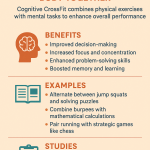Athletes vs. Non-Athletes and the Prefrontal Cortex
Athletes vs. non-athletes: what brain scans reveal about the prefrontal cortex may surprise you. The prefrontal cortex—responsible for decision-making, focus, impulse control, and emotional regulation—is one of the most important regions of the human brain. Studies show that athletes, thanks to regular training and competition, often develop stronger, more efficient prefrontal cortex function compared to non-athletes. This means sharper thinking, better resilience under pressure, and improved problem-solving skills.
In this comprehensive guide, we’ll explore how brain imaging studies highlight key neurological differences between athletes and non-athletes. We’ll also dive into the science behind these differences, real-world implications for performance and mental health, and what this means for anyone looking to strengthen their brain through physical activity.
Why Focus on the Prefrontal Cortex?
The prefrontal cortex (PFC) sits at the very front of the brain and is often called the “CEO of the mind.” It governs:
- Executive Function: Planning, decision-making, problem-solving
- Attention Control: Filtering distractions and focusing on priorities
- Impulse Regulation: Controlling urges and delaying gratification
- Emotional Balance: Managing stress and regulating mood
For athletes, the prefrontal cortex plays a critical role in strategic thinking during competition, staying calm under pressure, and executing precise motor control. Brain scans show that years of training reshape this brain region in measurable ways.
Brain Scans: How They Reveal Athlete vs. Non-Athlete Differences
Modern neuroimaging allows scientists to compare the brains of athletes and non-athletes in remarkable detail. Key methods include:
- fMRI (Functional Magnetic Resonance Imaging): Measures brain activity by detecting blood flow changes.
- DTI (Diffusion Tensor Imaging): Maps white matter pathways to see how efficiently different brain regions communicate.
- EEG (Electroencephalography): Records brainwave activity, showing real-time focus and attention levels.
Studies consistently find that athletes show enhanced prefrontal cortex activity, stronger connectivity, and improved efficiency compared to sedentary individuals.
What Brain Scans Reveal: Athletes vs. Non-Athletes
1. Enhanced Decision-Making and Cognitive Control
A 2018 study in the Journal of Sport and Health Science found that elite athletes display increased activation in the dorsolateral prefrontal cortex, a region linked to decision-making and cognitive control. This means athletes can assess situations faster and make better choices under pressure compared to non-athletes.
2. Stronger White Matter Connectivity
DTI scans reveal that athletes have more robust white matter tracts connecting the prefrontal cortex with motor and sensory regions. This improves reaction time, motor planning, and overall brain efficiency.
3. Superior Attention and Focus
EEG studies show that athletes have stronger alpha wave activity in the prefrontal cortex, associated with calm focus and reduced mental noise. Non-athletes tend to struggle more with sustained attention, particularly under stress.
4. Better Emotional Regulation
Brain scans highlight that athletes display stronger activation in the ventromedial prefrontal cortex, which regulates emotional responses. This means athletes are often more resilient under stress, while non-athletes may show heightened anxiety responses.
5. Structural Differences
MRI scans indicate that athletes sometimes have greater gray matter volume in the prefrontal cortex, especially those engaged in sports requiring strategy and coordination. Non-athletes show less structural reinforcement due to lower cognitive demands on this brain region.
The Science Behind These Differences
Neuroplasticity and Training
The human brain is adaptable. Through neuroplasticity, repeated experiences reshape neural connections. Athletes train their brains as much as their bodies:
- Motor Skills: Practice strengthens motor-prefrontal cortex pathways.
- Strategic Thinking: Constant decision-making in sports enhances executive function.
- Stress Exposure: Frequent competition builds resilience and emotional control.
Exercise-Induced Brain Chemicals
- BDNF (Brain-Derived Neurotrophic Factor): Exercise increases BDNF, fostering neuron growth and stronger synaptic connections in the PFC.
- Dopamine and Serotonin: Regular training balances these neurotransmitters, improving motivation and mood regulation.
Energy and Oxygen Supply
Exercise increases blood flow and oxygen delivery to the brain, especially to high-demand regions like the prefrontal cortex. Non-athletes, with lower cardiovascular fitness, often show reduced cerebral blood flow.
Sports That Sharpen the Prefrontal Cortex the Most
Not all sports impact the brain equally. Brain scans suggest that sports requiring complex strategies, quick decision-making, and coordination stimulate the prefrontal cortex the most:
- Team Sports (Soccer, Basketball, Hockey): Require split-second decisions, multitasking, and emotional control.
- Combat Sports (Martial Arts, Boxing): Train impulse control, focus, and stress regulation.
- Endurance Sports (Marathon, Triathlon): Build mental stamina and executive function.
- Precision Sports (Archery, Golf): Enhance concentration, patience, and emotional balance.
Non-athletes miss out on these constant challenges, leaving their prefrontal cortex under-stimulated.
Studies Comparing Athletes and Non-Athletes
- University of Illinois Study (2017): Found that college athletes had significantly higher prefrontal cortex activation during working memory tasks compared to non-athletes.
- Chinese Academy of Sciences (2019): Used MRI scans to show that table tennis players had thicker prefrontal cortices than sedentary individuals.
- Stanford University Research: Demonstrated that exercise-induced neuroplasticity leads to better impulse control and focus in athletes.
- Harvard Medical School Findings: Even moderate exercise leads to measurable prefrontal cortex growth, while inactivity contributes to cognitive decline.
Mental Health Implications
Athletes benefit from brain changes that extend beyond performance:
- Lower Anxiety Levels: Stronger prefrontal cortex regulation reduces overactivation of the amygdala (fear center).
- Better Stress Response: Athletes maintain calm during high-pressure scenarios.
- Improved Resilience: Mental toughness is reinforced by neurological adaptations.
Non-athletes, with weaker prefrontal cortex function, may experience higher rates of stress-related issues, impulsivity, and emotional imbalance.
Real-World Examples
Michael Jordan: Strategic Brilliance
Jordan’s ability to anticipate moves and control emotions under pressure reflects a highly trained prefrontal cortex, as supported by sports neuroscience research.
Serena Williams: Emotional Regulation
Williams demonstrates exceptional prefrontal activation, maintaining composure in intense matches, a skill enhanced by years of training.
Tom Brady: Decision-Making Speed
NFL studies show quarterbacks like Brady rely heavily on prefrontal cortex activation for split-second strategy and execution.
Can Non-Athletes Train Their Prefrontal Cortex?
Absolutely. Brain scans show improvements in non-athletes after regular exercise programs:
- Aerobic Training: Jogging, cycling, or swimming increases prefrontal blood flow.
- Mind-Body Practices: Yoga and meditation enhance attention control and emotional regulation.
- Skill-Based Activities: Dance, martial arts, and new sports challenge both body and brain.
Even non-athletes can boost prefrontal cortex function significantly with consistent activity.
The Broader Implications: Schools, Workplaces, and Society
Education
Schools that integrate sports show improved student performance, largely due to prefrontal cortex development.
Workplaces
Active employees display stronger focus, better problem-solving, and reduced stress. Sedentary employees are more prone to distraction and burnout.
Aging Population
Exercise helps preserve prefrontal cortex volume and function, lowering risks of cognitive decline.
Infographic: Athletes vs. Non-Athletes and the Prefrontal Cortex
Title: Brain Scan Differences in Athletes vs. Non-Athletes
- Athletes: Higher prefrontal activation, stronger white matter, better focus.
- Non-Athletes: Lower activation, weaker emotional regulation, slower decision-making.
- Exercise increases BDNF, oxygen supply, and brain connectivity.
Conclusion: Training the Prefrontal Cortex Through Movement
Athletes vs. non-athletes: brain scans reveal a clear difference in prefrontal cortex structure and function. Regular physical activity not only sharpens focus and decision-making but also enhances emotional resilience and long-term brain health. The good news? Non-athletes can train their brains too. Whether through sports, exercise, or mindful movement, strengthening the prefrontal cortex is within everyone’s reach.
The science is clear: if you want a sharper mind, stronger decisions, and better emotional balance—get moving. Athletes may have the head start, but anyone can sweat their way to a stronger prefrontal cortex.
What Japanese Brain-Scan Research Reveals About Gymnast Neuroplasticity
An illuminating study reported by The Asahi Shimbun reinforces this deep dive into neuroplastic changes in Olympic-level gymnasts—which aligns perfectly with our core topic.
Researchers led by Hidefumi Waki at Juntendo University conducted MRI scans on 10 male gymnasts with world-class credentials and compared them to a control group of non-athlete males. Strikingly, certain regions of the gymnasts’ cortex were about 10% larger—notably the precentral gyrus (motor function) and the inferior parietal lobule (involved in spatial perception and sensory integration) 朝日新聞.
Furthermore, the team discovered that athletes with higher average competition scores tended to have larger volumes in the inferior parietal lobule, suggesting that long-term training reshapes brain regions tied to spatial and sensory processing 朝日新聞. Interestingly, no regions were found to be smaller, underscoring that these adaptations appear to be built—not traded off.
Waki notes that gymnasts’ ability to make split-second body adjustments—even before initiating movement—is central to their expertise 朝日新聞. These insights dovetail with our discussion on prefrontal recalibration, motor-visual integration, and the emergence of autopilot-like performance in elite athletes.
Shaolin monks brain scan research not only highlights incredible focus and resilience but also connects deeply to modern health and wellness practices. Their disciplined lifestyle—balancing meditation, movement, and mindfulness—shows us how ancient wisdom aligns with today’s science-backed approaches to stress management, emotional regulation, and overall well-being.



